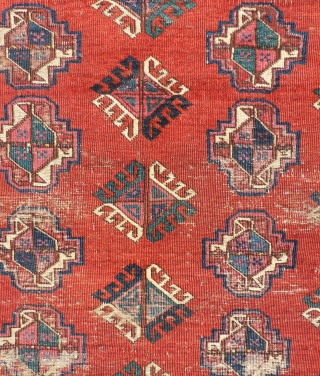Back
This small Middle Amu Daria Turkmen carpet is of unknown tribal origin, but has the look of a Salor Turkmen weaving. The spacing of the guls is generous and lends a main carpet feel to the rug without the size. It measures 47 x 65 inches and is reasonably finely woven with asymmetrical knots open to the right. It’s selvedges are missing, but it is otherwise complete except for the guard borders on each end. Most pile weavings from the Middle Amu Daria region that have this look are in the juval format and rarely seem much earlier than the middle to the third quarter of the 19th century. This weaving must be the great grandfather of those. It is hard to assign a date to the rug, but it must be no later than the first half of the 19th century and it’s possible it could reach back into the 18th century. Such early dates are not normally associated with the m.a.d. juvals displaying this gul, but this rug is something else. It has an archaic look and the back seems ancient. It is hard to know how early it might be because of a lack of comparable examples. i may be stretching it a bit, but for me a circa 1800 date is not out of the question. The rug needs to be handled and some preconceptions overcome for this possibility to sink in.
The rug has 12 colors with two colors of insect dyed silk. Two of the red wool colors in the rug also appear to be insect dyed like those found in some early Turkmen weavings. Small Turkmen rugs of this size are not common and usually are rather late, even so the format is pleasing as they usually imitate main carpet layouts, at least when woven by the Tekke tribes. The proportions of this small rug resemble those of certain early Salor weavings and for me it is a little bit like owning a shrunken Salor main carpet. Whoever wove this Middle Amu Daria rug, it is certainly a rare little Turkmen weaving that is both pleasing to live with and a bit of a curiosity.
price:
SOLD
- Home
- Antique Rugs by Region
- Category
- Profiles
- Post Items Free
- Albums
- Benaki Museum of Islamic Art
- Budapest: Ottoman Carpets
- Gulbenkian Museum
- Islamic Carpets. Brooklyn
- Islamic Textiles. Brooklyn
- Konya Museum: Rugs
- MKG, Hamburg
- MMA: Caucasian Carpets
- MMA: Mamluk Carpets
- MMA: Mughal Indian Carpets
- MMA: Ottoman Carpets
- MMA: Safavid Persian Carpets
- MMA: Turkmen Rugs
- McCoy Jones Kilims
- Ottoman textiles. Met
- Philadelphia Museum
- Rugs and Carpets: Berlin
- Seljuqs at the Met
- TIEM, Istanbul: Carpets
- V&A: Classical Carpets
- Vakiflar Carpets: Istanbul
- Baluch Rugs: Indianapolis
- Gallery Exhibitions
- Jaf an Exhibition
- Alberto Levi Gallery
- Andean Textile
- Christie's London: 2016
- Francesca Galloway
- HALI at 40
- ICOC Washington, DC 2018
- Jajims of the Shahsavan
- London Islamic Week April, 2018
- Mongolian Felts
- Navajo Rugs: JB Moore
- Persian Piled Weavings
- SF Tribal & Textile Art Show 2020
- SF Tribal 2019
- Sotheby's: C. Alexander
- Turkish Prayer Rugs
- Turkmen Main Carpets ICOC 2007
















